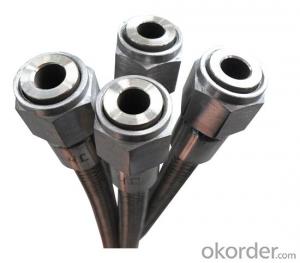Stainless Steel Braid Hose for Construction
- Loading Port:
- Tianjin
- Payment Terms:
- TT OR LC
- Min Order Qty:
- 1000 pc
- Supply Capability:
- 100000 pc/month
OKorder Service Pledge
OKorder Financial Service
You Might Also Like
Item specifice
Stainless Steel Braid Hose for Construction
Applications of Stainless Steel Braid Hose for Construction:
--Refueling system
--Chemical and pharmaceutical industry
--Industrial hydraulic systems
--Air conditioners in industrial and construction –site vehicles
--Food and beverage industry
--Special and standard industrial applications
--Water and cleaning management
Features of Stainless Steel Braid Hose for Construction:
1. )O. D.: 13-18MM 0.2-3M long
2. )Nut.: Nickel/Chrome Plated Brass (Zinc / Iron / Aluminum is available)
3. )Size Of Nut.: Female&Male 1/2''; 3/4''; 3/8''; 7/8''; 5/16'', and M10...
4. )Insert.: Brass (Zinc / Aluminum / Plastic is available)
5. )Inner tube.: Rubber/ EPDM/PVC
6. )Covered Material: Stainless Steel 201, 301, 304 /Aluminium Wire
7. )Working Pressure: 5Kg-15Kg
8. )Temperature: 0-92° C
9. )Quality Assurance: 3 years
RemarkAPPLICATION: HOUSEEHOLD WARE, BATHROOM WARE, SHOWER HOSE
PAYMENT: T/T, L/C
DELIVERY TIME: 20DAYS OR 30DAYS AFTER RECEIVED 30% DEPOSITS
MOQ: 5000PCS
ODM&OEM IS ACCEPTABLE
PackageInner: PP bag /Blister packing Outer: Carton box
Specifications of Stainless Steel Braid Hose for Construction:
NO | I.D | Refer to O.D | Working pressure | Burst pressure | approximate Weight | |||||
(inch) | (mm) | (inch) | (mm) | MPa | Psi | MPa | Psi | kg/m | lbs/ft | |
1 | 1/8 | 3.2±0.2 | 0.35 | 9±0.3 | 2.06 | 300 | 8.27 | 1200 | 0.078 | 0.12 |
2 | 5/32 | 4±0.2 | 0.4 | 10±0.3 | 2.06 | 300 | 8.27 | 1200 | 0.092 | 0.14 |
3 | 3/16 | 4.8±0.2 | 0.43 | 11±0.3 | 2.06 | 300 | 8.27 | 1200 | 0.108 | 0.16 |
4 | 1/4 | 6.3±0.3 | 0.5 | 12.7±0.3 | 2.06 | 300 | 8.27 | 1200 | 0.134 | 0.2 |
5 | 5/16 | 8.0±0.3 | 0.56 | 14±0.3 | 2.06 | 300 | 8.27 | 1200 | 0.147 | 0.22 |
6 | 3/8 | 9.5±0.3 | 0.63 | 16±0.4 | 2.06 | 300 | 8.27 | 1200 | 0.182 | 0.27 |
7 | 15/32 | 12±0.3 | 0.75 | 19±0.5 | 2.06 | 300 | 8.27 | 1200 | 0.238 | 0.35 |
8 | 1/2 | 12.7±0.4 | 0.78 | 20±0.5 | 2.06 | 300 | 8.27 | 1200 | 0.262 | 0.39 |
9 | 5/8 | 16±0.4 | 0.94 | 24±0.5 | 1.03 | 150 | 4.12 | 600 | 0.351 | 0.52 |
10 | 3/4 | 19±0.4 | 1.13 | 28.8±0.5 | 1.03 | 150 | 4.12 | 600 | 0.515 | 0.77 |
11 | 1 | 25.4±0.5 | 1.38 | 35±0.6 | 1.03 | 150 | 4.12 | 600 | 0.637 | 0.95 |
Images of Stainless Steel Braid Hose for Construction:
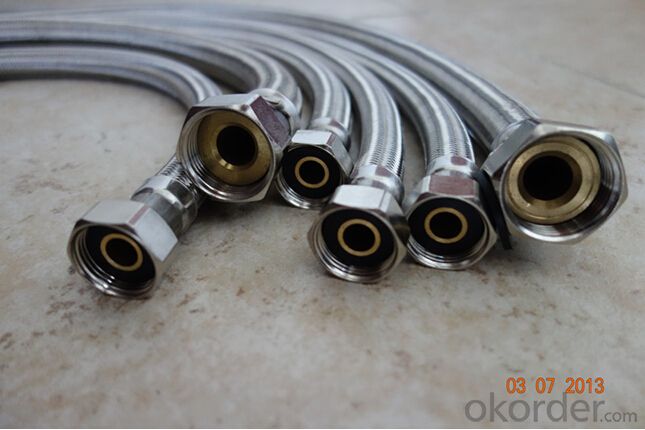
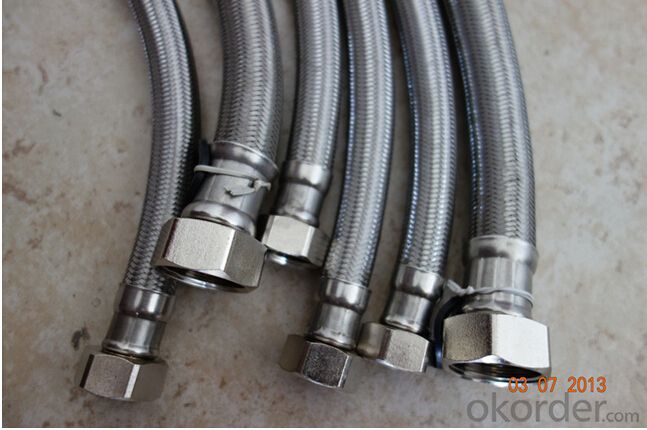
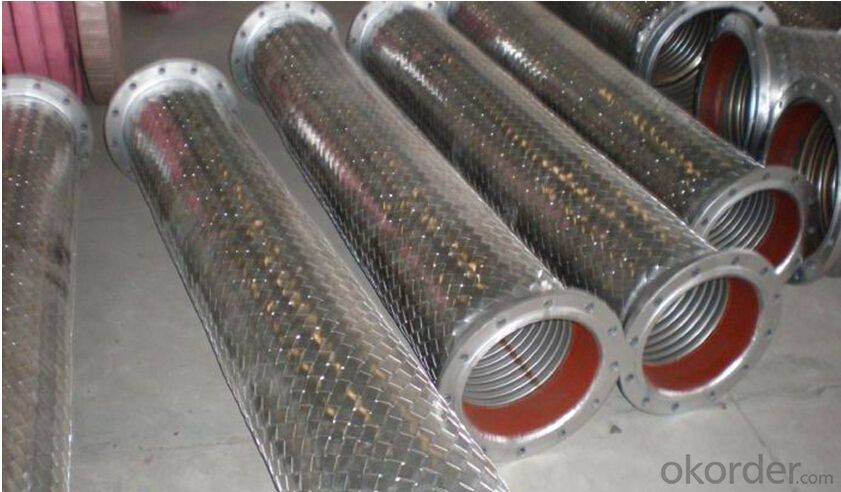
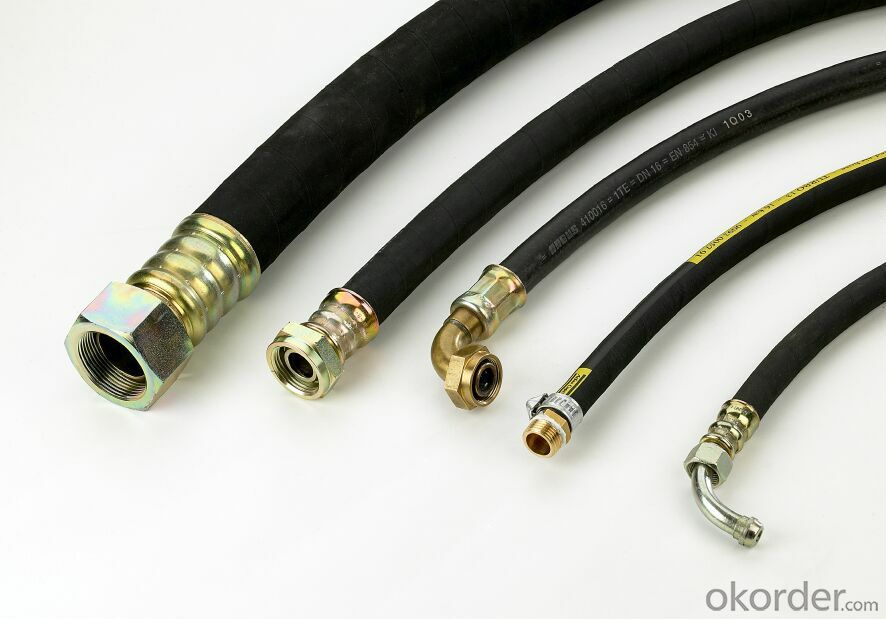
Package of Stainless Steel Braid Hose for Construction:
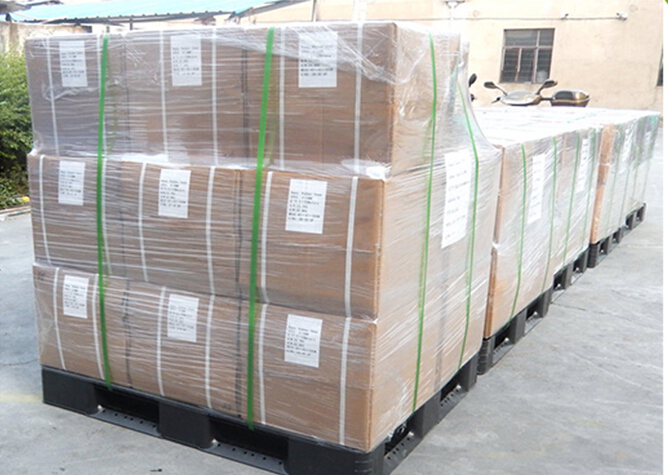
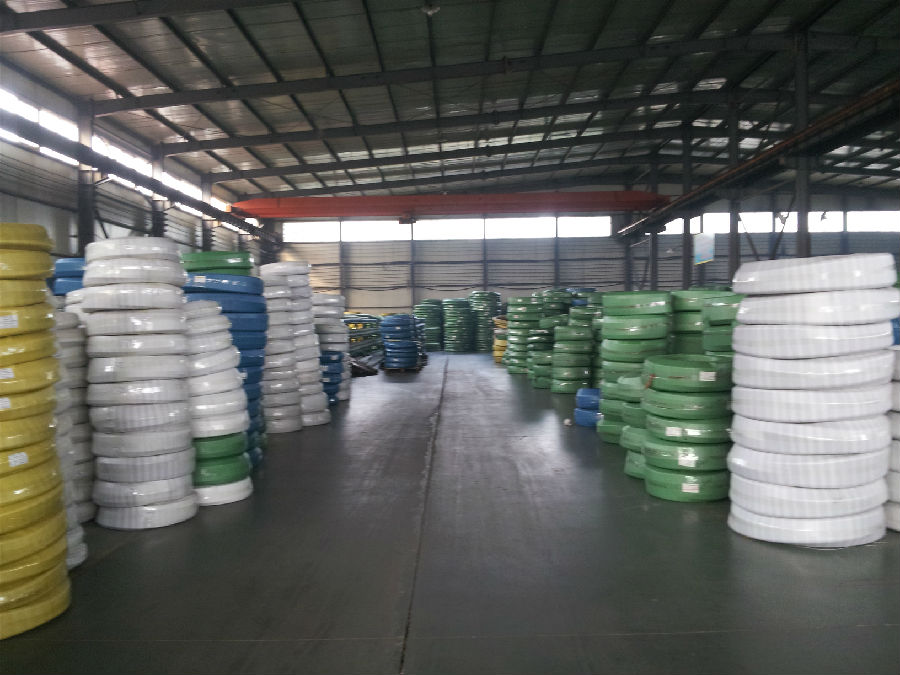
FAQ of Stainless Steel Braid Hose for Construction:
Who we are:
Answer: We CNBM is a Chinese state-owned enterprise ranked 267th among the Global Fortune 500, as the largest building materials company,we have over 300 affiliated companies,and so many production lines and branch office distribute in China.
2. About our quality:
Answer: Every product needs to be quality proved before shipping.
3. About our service:
Answer: We could gurantte that we can reply you in 2 working hours.
- Q:What is the difference between sanitary and industrial stainless steel pipes?
- Sanitary and industrial stainless steel pipes differ primarily in their intended use and the level of cleanliness required. Sanitary stainless steel pipes are specifically designed for applications in the food and beverage industry, pharmaceutical industry, and other sanitary environments where cleanliness and hygiene are of utmost importance. These pipes are manufactured with a higher level of surface finish, typically a smooth and polished surface, to prevent bacteria growth and ensure easy cleaning. The inner surface of sanitary pipes is often electropolished to further enhance its smoothness and resistance to corrosion. Additionally, sanitary pipes are often equipped with tri-clamp fittings or other sanitary connections to facilitate easy disassembly for cleaning purposes. On the other hand, industrial stainless steel pipes are used in a wide range of applications, including manufacturing, oil and gas, chemical processing, and construction. These pipes are typically designed to withstand high pressures, extreme temperatures, and harsh environments. Industrial pipes may have a rougher surface finish and may not require the same level of cleanliness as sanitary pipes. They are often welded or threaded together for assembly and are built to withstand heavy-duty usage. In summary, the main differences between sanitary and industrial stainless steel pipes lie in their intended use, surface finish, and level of cleanliness required. Sanitary pipes prioritize hygiene and ease of cleaning, making them suitable for food and pharmaceutical applications. Industrial pipes, on the other hand, focus on durability and strength to withstand demanding industrial environments.
- Q:Mechanical properties of stainless steel tubes
- Strength (tensile strength, yield strength) the strength of stainless steel is determined by various factors, but the most important and basic factor is the addition of different chemical factors, mainly metallic elements. Different types of stainless steel have different strength characteristics due to their differences in chemical composition.
- Q:What is the difference between 304J9 and 316J9 stainless steel pipes?
- The main difference between 304J9 and 316J9 stainless steel pipes is their composition and corrosion resistance. 304J9 contains a higher amount of chromium and nickel, making it more resistant to corrosion in general environments. On the other hand, 316J9 has molybdenum added to its composition, providing enhanced resistance to corrosion, especially in chloride-rich environments, such as marine settings.
- Q:What are the different grades of stainless steel used in pipe manufacturing?
- The different grades of stainless steel used in pipe manufacturing include 304, 316, 321, and 347.
- Q:What is the difference between 304J3 and 316J3 stainless steel pipes?
- The main difference between 304J3 and 316J3 stainless steel pipes lies in their composition and corrosion resistance properties. 304J3 stainless steel is a grade of stainless steel that contains 18% chromium and 8% nickel. It is known for its excellent corrosion resistance, high strength, and good formability. This grade is commonly used in various applications, such as food processing, chemical processing, and architectural applications. On the other hand, 316J3 stainless steel is a grade that contains 16-18% chromium, 10-14% nickel, and 2-3% molybdenum. This additional molybdenum content enhances its corrosion resistance, especially against chloride environments. As a result, 316J3 stainless steel is often used in more demanding applications, such as marine environments, pharmaceutical equipment, and coastal structures. In summary, the key difference between 304J3 and 316J3 stainless steel pipes is the composition and the subsequent corrosion resistance properties. While both grades offer good corrosion resistance, 316J3 stainless steel provides superior resistance in chloride-rich environments, making it suitable for more demanding applications.
- Q:How do you prevent blockages in stainless steel pipes?
- To prevent blockages in stainless steel pipes, there are several measures you can take: 1. Regular cleaning: Clean the pipes on a regular basis to remove any accumulated debris or residue. This can be done using various cleaning methods such as mechanical cleaning tools or chemical cleaning solutions that are safe for stainless steel. 2. Proper disposal of waste: Ensure that you dispose of waste materials properly, avoiding dumping substances that can cause blockages, such as grease, oil, food scraps, or other solids. Use appropriate waste disposal systems or filters to trap these substances before they enter the pipes. 3. Avoid corrosive substances: Stainless steel pipes are resilient to corrosion, but exposure to certain highly corrosive substances can cause damage and blockages. Avoid using or disposing of chemicals or substances that are known to corrode stainless steel pipes. 4. Regular inspections: Conduct regular inspections of the pipes to identify any signs of blockages or potential issues. This can help in detecting problems early on and taking necessary preventive measures. 5. Proper installation: Ensure that the pipes are installed correctly, with proper alignment, support, and connections. This will help prevent the formation of blockages due to misaligned or poorly connected pipes. 6. Use strainers or filters: Install strainers or filters at the entry points of the pipes to catch any large particles or debris that can potentially block the pipes. Regularly clean or replace these strainers to maintain their effectiveness. 7. Avoid high-temperature buildup: Excessive heat can cause substances to solidify or congeal, leading to blockages. Avoid allowing substances to cool and solidify in the pipes by maintaining a suitable temperature and preventing sudden temperature changes. 8. Regular maintenance: Implement a regular maintenance schedule to keep the pipes in optimal condition. This can include activities such as flushing the pipes with hot water or using specialized cleaning solutions to remove any buildup or residue. By following these preventive measures, you can significantly reduce the chances of blockages in stainless steel pipes, ensuring their long-term functionality and minimizing the need for costly repairs or replacements.
- Q:Can stainless steel pipes be used for compressed air systems?
- Yes, stainless steel pipes can be used for compressed air systems. Stainless steel is highly resistant to corrosion and can withstand high pressure, making it a suitable material for handling compressed air.
- Q:Are stainless steel pipes suitable for brewery applications?
- Yes, stainless steel pipes are highly suitable for brewery applications. Stainless steel is corrosion-resistant, ensuring that the pipes can withstand the harsh chemicals and acids used in the brewing process. It is also easy to clean and maintain, making it ideal for maintaining the hygiene standards required in breweries. Additionally, stainless steel pipes do not impart any taste or odor to the beer, ensuring the quality and purity of the final product.
- Q:What is the lifespan of stainless steel pipes?
- The lifespan of stainless steel pipes can vary depending on various factors such as the grade of stainless steel used, the environment in which they are installed, and the maintenance and care they receive. However, in general, stainless steel pipes have a long lifespan compared to other materials commonly used for piping systems. Stainless steel pipes are known for their durability and corrosion-resistant properties. They are designed to withstand harsh conditions, high temperatures, and various corrosive substances, making them suitable for a wide range of applications. This inherent resistance to corrosion allows stainless steel pipes to have a longer lifespan than pipes made from materials like carbon steel or plastic. In ideal conditions and proper maintenance, stainless steel pipes can last for several decades or even longer. In some cases, stainless steel pipes have been known to last for over 100 years. However, it is important to note that the actual lifespan can vary depending on the specific application and the level of care provided. Regular inspection, maintenance, and cleaning can help extend the lifespan of stainless steel pipes. This includes removing any deposits or buildup that may occur over time, as well as addressing any signs of corrosion or damage promptly. Additionally, choosing the appropriate grade of stainless steel for the intended application can also contribute to a longer lifespan. Overall, stainless steel pipes are known for their durability and longevity. With proper care and maintenance, they can provide reliable and efficient performance for many years, making them a popular choice in various industries and applications.
- Q:How do stainless steel pipes compare to brass pipes?
- Stainless steel pipes are generally more durable, corrosion-resistant, and have higher heat resistance compared to brass pipes. Additionally, stainless steel pipes are often more cost-effective in the long run due to their longevity and low maintenance requirements. Brass pipes, on the other hand, are known for their excellent conductivity and aesthetic appeal. Ultimately, the choice between stainless steel and brass pipes depends on the specific needs and preferences of the application.
1. Manufacturer Overview |
|
|---|---|
| Location | |
| Year Established | |
| Annual Output Value | |
| Main Markets | |
| Company Certifications | |
2. Manufacturer Certificates |
|
|---|---|
| a) Certification Name | |
| Range | |
| Reference | |
| Validity Period | |
3. Manufacturer Capability |
|
|---|---|
| a)Trade Capacity | |
| Nearest Port | |
| Export Percentage | |
| No.of Employees in Trade Department | |
| Language Spoken: | |
| b)Factory Information | |
| Factory Size: | |
| No. of Production Lines | |
| Contract Manufacturing | |
| Product Price Range | |
Send your message to us
Stainless Steel Braid Hose for Construction
- Loading Port:
- Tianjin
- Payment Terms:
- TT OR LC
- Min Order Qty:
- 1000 pc
- Supply Capability:
- 100000 pc/month
OKorder Service Pledge
OKorder Financial Service
Similar products
New products
Hot products
Hot Searches
Related keywords

